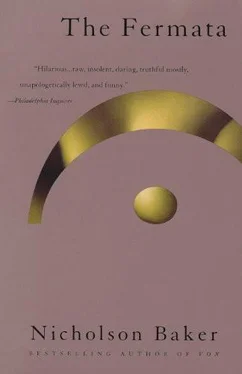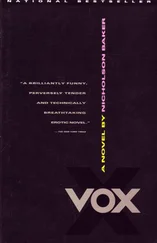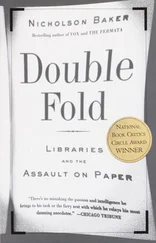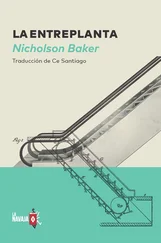Nicholson Baker - The Fermata
Здесь есть возможность читать онлайн «Nicholson Baker - The Fermata» весь текст электронной книги совершенно бесплатно (целиком полную версию без сокращений). В некоторых случаях можно слушать аудио, скачать через торрент в формате fb2 и присутствует краткое содержание. Год выпуска: 1996, Издательство: Vintage, Жанр: Современная проза, на английском языке. Описание произведения, (предисловие) а так же отзывы посетителей доступны на портале библиотеки ЛибКат.
- Название:The Fermata
- Автор:
- Издательство:Vintage
- Жанр:
- Год:1996
- ISBN:нет данных
- Рейтинг книги:4 / 5. Голосов: 1
-
Избранное:Добавить в избранное
- Отзывы:
-
Ваша оценка:
- 80
- 1
- 2
- 3
- 4
- 5
The Fermata: краткое содержание, описание и аннотация
Предлагаем к чтению аннотацию, описание, краткое содержание или предисловие (зависит от того, что написал сам автор книги «The Fermata»). Если вы не нашли необходимую информацию о книге — напишите в комментариях, мы постараемся отыскать её.
The Fermata — читать онлайн бесплатно полную книгу (весь текст) целиком
Ниже представлен текст книги, разбитый по страницам. Система сохранения места последней прочитанной страницы, позволяет с удобством читать онлайн бесплатно книгу «The Fermata», без необходимости каждый раз заново искать на чём Вы остановились. Поставьте закладку, и сможете в любой момент перейти на страницу, на которой закончили чтение.
Интервал:
Закладка:
At first that summer I watched the wash with the lid up just because I enjoyed it — I liked imagining myself as an agitator, shouldering the water powerfully back and forth with my fins; but eventually I began to suspect that untapped temporal powers resided in the spin cycle. Nothing that could safely displace articles of clothing in a circle that fast could fail to be of help to me in my effort to discover a second way, after the race-track transformer, to remove the clothes of girls and women without their knowledge. There were words molded on the tops of the agitators’ spindles — ours said SURGILATOR — and one day I let my fingers rest lightly on this rotifer of meaning as its final acceleration began. The word, made slightly slippery from residual soap, circulated progressively faster under my touch until, vibrating into unreadability, its letters merged into a whirling probabilistic annulus, and I felt that the secret of spin had been communicated from the machine to me.
And I was right — the secret of spin was indeed at my fingertips — but it took a while for me to discover how exactly to put it to work. At first I thought that I had to spin. I went outside at twilight and practiced whirling with arms outstretched, not too terribly troubled by the possibility that I might remind an onlooker of Julie Andrews in The Sound of Music , trying to get my red blood cells to crowd down my forearms with such force that the tips of my fingers would blow off and I would hemorrhage triumphantly over the pachysandra. But of course my fingertips held and time ticked on. (Fingertips are so durable. They don’t even explode when you use them as temp shoehorns; they just tingle for a second as your impassive heel forces itself past.) Even so, I knew I was on the right track experimentally when, just around that time, I came across a paperback about UFOs in a carousel at a Mass Pike gift shop. It was a collection of letters from the general public to the air force describing flying-saucer sightings, interior layouts, and so on. One of the letters was from a man who thought that UFOs were generating the antigravity forces on which they supposedly hovered by spinning quantities of loose dirt and boulders in a doughnut-shaped inner ring built into the perimeter of the spacecraft. The author of the letter supplied a rough illustration which showed the rotating fill and the resultant lift. I knew that his idea was flawed and foolish, but I also knew that he had rightly sensed, as I had, centrifugation’s evocative peculiarity, its possibly mystical potential. It wasn’t the pull of gravity that spin would neutralize, I felt; it was the pull of time.
The longer I studied our washing machine with the lid open, the more I realized that “for best results” I would have to be directly linked to the unnatural forces that my clothes were experiencing. But I hesitated to climb into the clothes basket. I had heard stories of broken fingers and dislocated shoulders. I thought, however, that if I had a way of plucking something of my own abruptly from a state of extreme spin and putting it on while it was still damp, time would be shocked to a stop until my garment dried. It was worth a try, anyway. Just at the close of a rinse cycle, I tied a length of brown twine around a dripping dark-red T-shirt as tightly as I could and tossed it back in the machine. When the spinning began I stood on a chair and held the end of the twine above the basket so that it could bobbin freely. At the right moment I jerked hard on the twine, shouting, “Now!” My red T-shirt flew twirling into the room like a flushed duck. I put it on and ran outside, full of hope. But the two-tone leaves were aflutter on the lindens and I could hear the usual traffic, so I knew that I had failed. I liked letting the shirt dry and its color lighten on me, though.
A few days later, when there were enough dirty clothes to make another load, I hammered a finishing nail into the table next to the washing machine and mounted a spool of heavy-duty thread onto it. I wound the end of the thread clockwise around the spindle of the washing machine at the commencement of spin. Thread transfer proceeded with increasing speed. The little spool wobbled wildly as it was stripped of its cotton integument. I grabbed the spool and held it tightly, so that the thread being drawn into the machine had to snap — at that instant of rupture I expected time to be all mine. But time wasn’t mine even then; I still, it seemed, wasn’t connected intimately enough to the pure state of spin.
As so often happens, success finally came through the convergence of several independent paths of research. There was a long rope swing in our back yard. I had been climbing this swing a little higher every day, on the hunch that something unusual might happen when I was able to make it all the way to the knot at the top, which was perhaps thirty feet off the ground. The rope was smooth where we normally held it to swing (sitting on a rolled-up remnant of industrial carpeting tied in place and launching ourselves from a wooden refrigerator crate), but the higher I climbed, the rougher its hempen texture became. Every day I got a little stronger, in my stomach muscles as well as my arms, and I also got better at relieving some of the burden on my arms by winding the rope around one leg and clamping it between the top of one sneaker and the sole of the other. My hands burned more each time. I opened and closed my fists when I was safely back on the ground to make the pain inside them go away. After a week and a half, I finally reached the knot at the top and slapped the finely cracked bark on the load-bearing bough, amazed and even somewhat terrified that I had been able to work my way up so high. I expected, after that conquering slap, to return to earth with new powers, but in fact I had no new powers: I only had fourteen or fifteen excellent oval calluses on my fingers, of which I was very proud. In private I pushed at these calluses while I was thinking.
One weekend during this period my father took me to the hardware store. A man we called the Needle Man was in the parking lot. The Needle Man was deaf and dumb; he went around the city selling packets of sewing needles for a living. He was a short, toothless person of about sixty who always wore a baseball cap; there was something wrong with one of his knees, which bent sideways when he put his weight on it. He approached us and went into his silent sales pitch: he flashed the packet of needles, shrugged, looked away, flashed the packet of needles again, licked his thumb and tested the wind direction, smiled, gummed, shrugged, looked away, looked at us. My father gave him a dollar for the needles. The Needle Man nodded and left us. He never showed gratitude. I connected him with Rumpelstiltskin and with Gollum in The Hobbit . We already had five or six packets of needles that we had bought from him, so my father handed this one to me. “Maybe you can think of something to do with them,” he said.
And I did think of something, as a matter of fact. I got a fresh spool of thread from the sewing basket. I opened the packet of needles, which had a convenient front flap like a book of matches. The needles were arranged by size and resembled the pipes in a pipe organ; they were pinned with exactitude through two folds of blue foiled paper — a hand-held cathedral. I chose a medium needle, threaded it, and spent most of the afternoon sewing my rope-climbing calluses together in various ways. When the needle was partway through a callus I tapped its tip to feel the tension within the thickened skin; the sensation was usually painless. I waggled my fingers with two needles poked into them in the mirror, pretending I was being tortured. When I had pushed a needle all the way through, the thread that followed was almost ticklish; my nerves were being stimulated in a way that left them uncertain about what was inside and what was outside. It was as if I could hear the thread tugging through the holes in my skin rather than feel it. I sewed all eight fingertips in series and walked around the house moaning and looking for an audience; then I played something very simple by Bach on the piano — the additional presence of the thread in the moment of contact with each piano key, and the restricted range my fingers had, made the music seem unusually pointed and intelligent and pure. I played better, more high-steppingly, more like Glenn Gould, with sewn hands (though with many more wrong notes) — just as show horses were (I had read somewhere) made by unethical trainers to strut prize-winningly with mustard and chains in their fetlocks. I was my own marionette. I stopped the Bach in the middle and closed the piano lid. And as I closed the lid I knew what I was meant to do.
Читать дальшеИнтервал:
Закладка:
Похожие книги на «The Fermata»
Представляем Вашему вниманию похожие книги на «The Fermata» списком для выбора. Мы отобрали схожую по названию и смыслу литературу в надежде предоставить читателям больше вариантов отыскать новые, интересные, ещё непрочитанные произведения.
Обсуждение, отзывы о книге «The Fermata» и просто собственные мнения читателей. Оставьте ваши комментарии, напишите, что Вы думаете о произведении, его смысле или главных героях. Укажите что конкретно понравилось, а что нет, и почему Вы так считаете.












